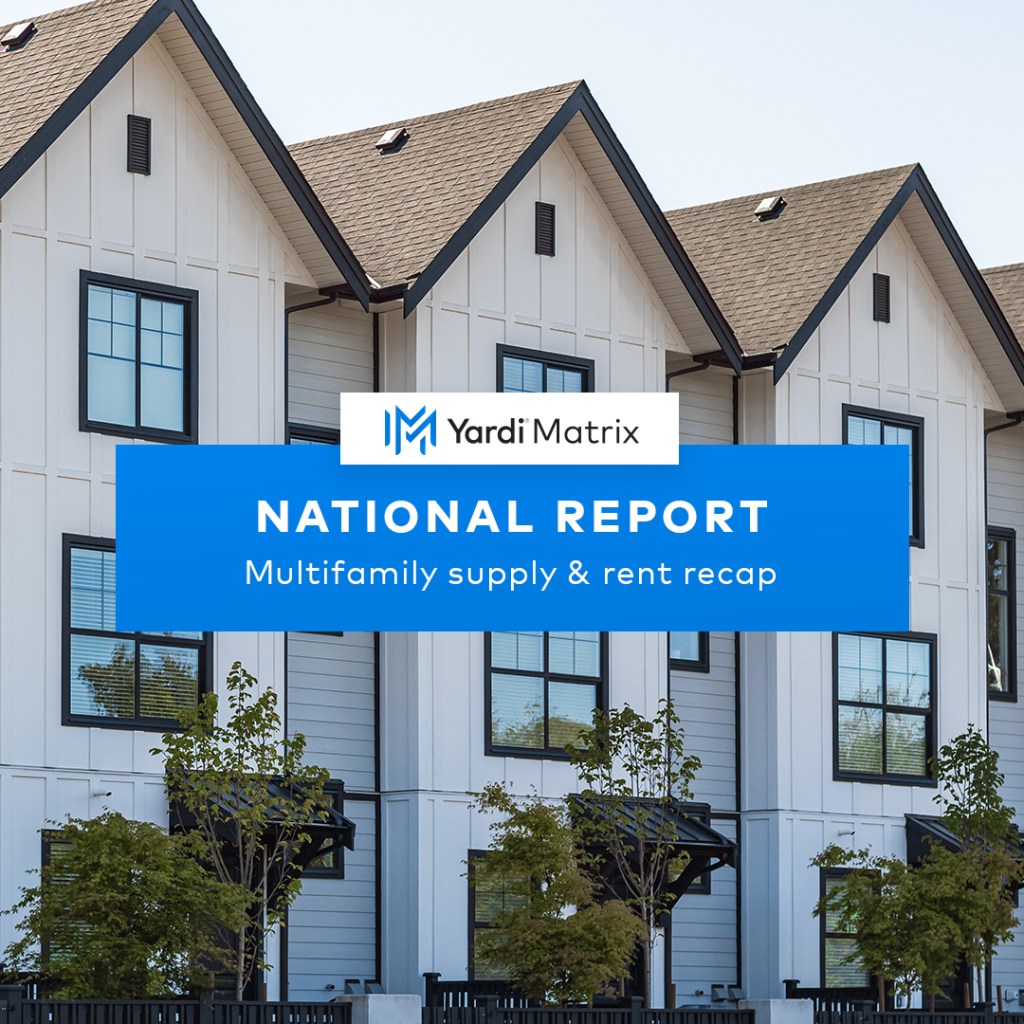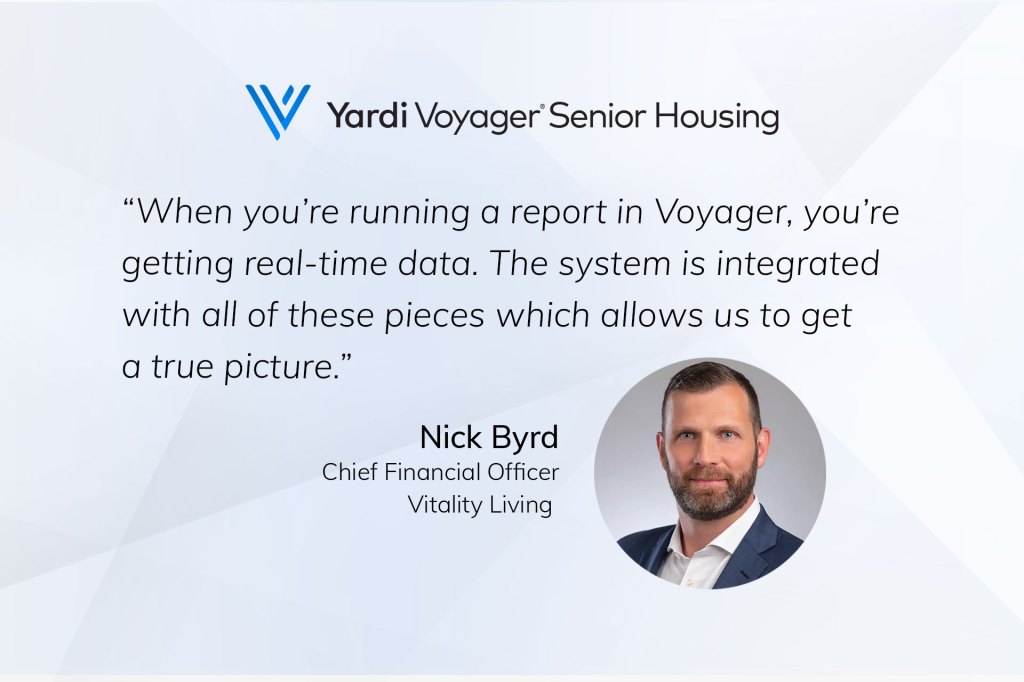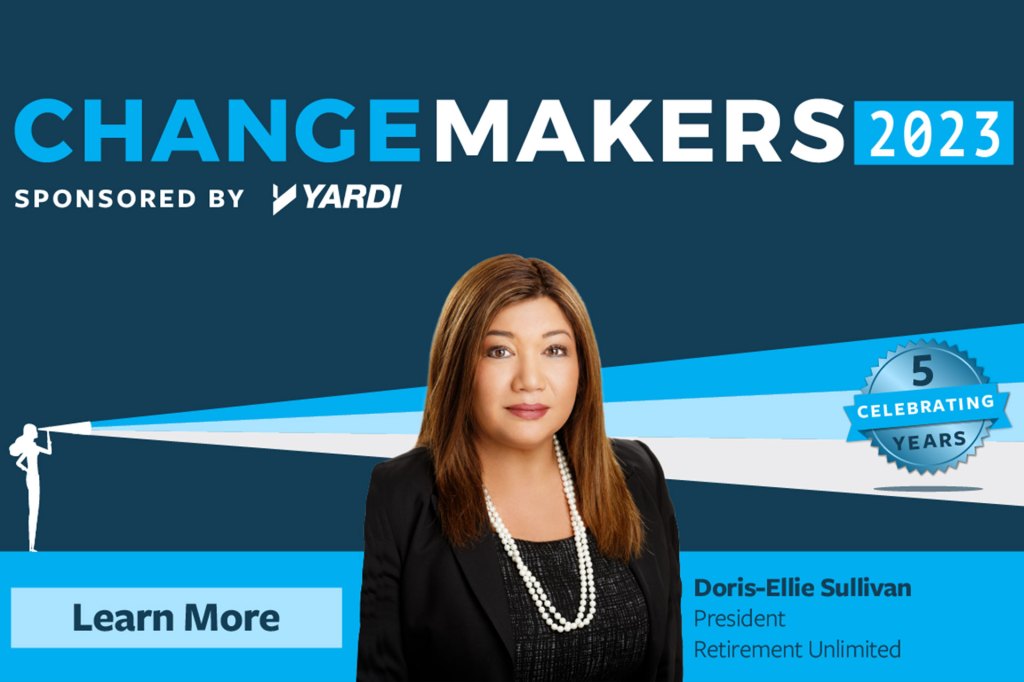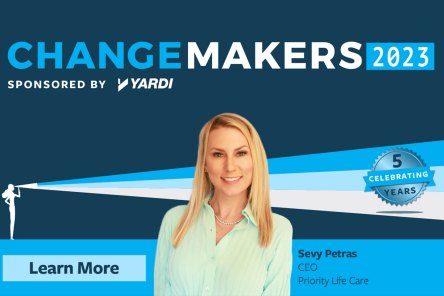Multifamily asking rents rose for the third straight month in May, according to the latest National Multifamily Report from Yardi Matrix. Despite the threat of a slowing economy looming, average U.S. asking rent rose $7 in May to $1,716, while year-over-year growth decelerated to 2.6 percent. That was the lowest level since March 2021. For the year to date, rents are up $18, or one percent since January 1. The seasonal outline of growth is not far off a typical pre-pandemic year, although the rate of increase is lower. “While performance displays resilience, the data is not unambiguously positive as it has been for most of the last two years,” states the report. “Rent growth has turned negative year-over-year in several metros as occupancy rates weaken amid slackening demand and rapid growth in new deliveries.” Overall market attitudes remain positive. Renting is still cheaper than owning, and first-time buyers are renting longer. The stickiness of high-income renters likely contributes to the recent resurgence in high-end Lifestyle properties, in which rents rose 0.4 percent in May. The average single-family unit rent reached $2,100 for the first time in May, about a year after topping the $2,000 mark. Year-over-year growth fell 40 basis points to 2.1 percent. SFRs are boosted by waning home sales attributed to high interest rates and limited inventory. Gain more insights by downloading May’s Multifamily...
Organic Soup Kitchen
Benefitting Wellbeing
Yardi is committed to supporting the community in every city where our offices are housed. Each year, the company distributes philanthropic aid to organizations selected by its employees. Let’s head to Santa Barbara and introduce you to Organic Soup Kitchen, founded in 2009, which has been making and delivering nutrient-dense SoupMeals to low-income seniors, cancer patients and chronically ill community members throughout Santa Barbara County. Today they provide to more than 20,000+ residents annually through a network of more than 50 volunteers and health and human service agency partners. Organic Soup Kitchen will open a second location in downtown Santa Barbara this month to expand its efforts to more vulnerable communities. Organic Soup Kitchen has scaled up operations to keep pace with the community’s needs as the demand for nutrition and food security has skyrocketed over the past few years. The extra work has quickly outgrown its kitchen facility and the new center will give Organic Soup Kitchen twice as much freezer space, which will not only increase capacity to make and serve SoupMeals, but it will also allow to rescue and stabilize additional produce that would otherwise end up in the landfill. “The new center will be a hub for nutrition education and SoupMeal distribution, helping us increase our accessibility to underserved and marginalized community members,” said Jennifer Hyle, development manager at Organic Soup Kitchen. Funding from Yardi has been critical for helping Organic Soup Kitchen provide lifesaving nutrition. Yardi’s contribution goes directly towards purchasing premium ingredients and biodegradable packaging for SoupMeals. Organic Soup Kitchen is thrilled to have gained the trust and support of employees at Yardi. “Receiving the news that our organization was nominated to receive funding was a great honor as we have always admired Yardi’s commitment to strengthening...
Yardi Acquires CloudVO
CRE Listing Service Network Expands
Yardi, the global leader in real estate software, announced the acquisition of CloudVO, the San Francisco-based online reseller of virtual offices, meeting rooms and other workplace services. Yardi’s listing service network includes sites such as CommercialCafé, CommercialSearch and PropertyShark, who have established prominent positions in the commercial real estate space. CoworkingCafé is dedicated to promoting coworking services, but all listing sites share the same database. Listing with one is listing with all, giving operators more exposure to anyone looking for coworking services than any other option. The Yardi listing network generates over 20,000 leads per month to participating commercial property owners and coworking operators. “We have closely followed CloudVO’s progress for many years now, and it seemed that the time was right to incorporate their assets and intimate knowledge of coworking operators into Yardi. We are looking forward to continuing this journey with Laurent and his team,” said Rob Teel, Yardi president of commercial. Laurent Dhollande, CEO of CloudVO, commented: “We are thrilled that CloudVO is now part of Yardi. Our partners will benefit from the Yardi listing service with infinitely more reach and strength than CloudVO could provide on its own, with seven online listing sites that combine over 3 million visitors monthly. Our customers will be exposed to a larger inventory and better choices for their online bookings and purchases of workplace services, including meeting rooms, private offices and virtual offices.” As of June 1, CloudVO ceased to take new orders and clients are being redirected to CoworkingCafe. Phone answering services will continue to be provided by CloudAnswering, without interruption, and are not part of the assets sold to Yardi. CloudAnswering will stay as a member of the Pacific Workplaces family of...
Remote Work Impact
On housing, communities and more
The impact of remote work on the housing market has been significant. In a webinar by Yardi Matrix, Jeff Adler, Matrix vice president, brought up several notable shifts. The full recording and presentation slides are available online. Let’s explore the big-picture impact of remote work on housing and communities. There are myriad cultural changes from the pandemic from an economic standpoint, but one of the most significant transitions is the prevalence of remote work. Working remotely offers more opportunities for household formation. In addition, with remote working becoming more prevalent, some employees are no longer tied to living near the offices. This has increased interest, particularly in suburban areas like Charlotte and Phoenix, where households can enjoy more space, lower living costs and a quieter lifestyle than in urban centers. Additionally, some businesses have chosen to leave high-cost cities for lower-cost ones, such as San Francisco to Austin, New York to the Carolinas and Chicago to Nashville. “I think Huntsville is a great market for many businesses, but it’s just now beginning to have a lot of supply hit,” said Adler. “Any place where you got to have a supply response will run through some struggles for the next couple of years as it gets absorbed.” In addition, research found that remote work has led to a surge in household formation, counterbalancing population loss in dense cities. First-time homebuyers are becoming priced out of the market, which encourages renting, especially while mortgage rates are at the highest level in more than 13 years. Household formation could stall as renters move in with family or roommates to cut costs. Remote work has given homeowners and renters more flexibility in choosing where to live. This has resulted in shifts in migration patterns. People are moving from...
Unlock Evolving Functionality
In RentCafe Senior CRM
Did you know 65% of sales professionals use CRM? And out of companies using mobile CRM, 65% achieved sales quota compared to 22% of those without mobile CRM? Case in point, with the right CRM solution, senior living operators are equipped to advance sales and marketing efforts in more ways than one. But it’s important to find a solution built for the unique needs of senior living — one equipped with tools that evolve as the industry does. Fortunately, we have just the solution in mind. Meet RentCafe Senior CRM, our mobile-friendly single connected solution. Read on to see what this one-of-a-kind platform offers today’s senior living operators. The sales and marketing tools you need There’s so much functionality to cover when it comes to RentCafe Senior CRM, but at a glance, the solution helps you: Configure and automate the sales process to guide your unique selling approach View real-time census data, occupancy status, unit rates and amenity offerings Eliminate duplicate data entry with a united leasing and move-in workflow Lead with confidence using a platform integrated with multiple elements of the Yardi Senior Living Suite Generate, complete and upload documents to RentCafe Senior Living Portal, where residents and family members can sign electronically Reduce risks with a solution that is HIPAA and SOX compliant Access visual reporting with configurable, group-based dashboards and a wide selection of KPIs Drive efficiency with a convenient mobile app built for iOS and Android devices Enjoy the convenience of Yardi as your single support avenue Offer residents a seamless move-in journey RentCafe Senior CRM doesn’t simply help you during the early stages of the sales cycle. It offers tools to power the cycle from start to finish, including the time leading up to move-in (once a prospect commits to your community). At that stage, you access: Up-to-date resident assessments A seamless leasing workflow equipped with rates, specials/discounts and approvals Easy-to-generate electronic leases The automatic attachment of documents to the resident record in Voyager Senior Housing And more! Evolving functionality like no other platform What else makes RentCafe Senior CRM a differentiator? To add to everything already mentioned, RentCafe Senior CRM offers: Inbound and outbound calling, texting and emailing Duration and engagement tracking Triggered activity follow-up Predictive analytics Automated prospect and referral correspondence Event management Third party API integrations Lead scoring An integrated solution built for senior living Of course, one of the biggest benefits of RentCafe Senior CRM is its ability to integrate with key elements of your business. While other CRM solutions may offer a few valuable features, they don’t always integrate with EHRs, financial platforms and everything in-between. As part of the Yardi Senior Living Suite, RentCafe Senior CRM connects with everything you need — saving time, eliminating errors and ensuring your teams have up-to-date information at all times. Level up with RentCafe Senior CRM Wondering how else RentCafe Senior CRM helps operators reach new heights? Reach out to book a quick, personalized demo. And in the meantime, feel free to explore our RentCafe Senior CRM infographic!...
W.A.G.S.4 Kids
Working Animals Giving Service
Let the magic begin! Today, we journey to Berea, Ohio, for a Yardi-supported nonprofit, Working Animals Giving Service for Kids (W.A.G.S. 4 Kids), founded in 2004. W.A.G.S. 4 Kids provides mobility, autism and psychiatric service dogs for children throughout 35 northeast and central Ohio counties utilizing an award-winning Ohio Department of Rehabilitation and Correction (ODRC) accredited Cell Dog Training Program. W.A.G.S. 4 Kids hopes to target ten more partnerships with their already 32 families under contract, 23 dogs in training and more than 90 families in the application process. “In short, our goal is the same as it ever was- more dogs to more kids with shorter wait times,” shared Sera Nelson, executive director for W.A.G.S. 4 Kids. Funding from Yardi goes directly to supplement the cost of each service dog, and this year is rising from $28,000 to $35,000 due to inflation costs of food, travel, dog supplies, veterinary care, medications and training. “Thanks to Yardi, we remain committed to providing these animals at only a small fraction of that cost to our families, but we cannot do it alone,” shared Nelson. W.A.G.S. 4 Kids presents an opportunity for a child they see spending their life having things done to them and for them to reach out physically and emotionally and engage with the world around them. With Yardi’s support, confidence is shown in what the dogs provide in services for children to gain confidence, independence and empowerment for their futures. “I don’t know if I have words specifically to describe the reaction to Yardi’s support. Gratitude, for sure. The feeling of being adopted. The feeling of being understood. Of our kids being adopted and understood…valued. Though our intention is always to enhance a child’s wellness, we often cannot quantify our services’ effects on the confidence, independence, and empowerment of a child’s future,” Nelson enthused. This June, one of the W.A.G.S. 4 Kids service pups in training will be named Yardi- look for pictures and puppy updates soon! Myles Accomplishment W.A.G.S. 4 Kids first service was with Myles from Strongsville, Ohio, a four-year-old boy with Cerebral Palsy and paralysis of his left side. Myles was non-verbal since birth and communicated with simple Sign Language. W.A.G.S. dog AJ was partnered with Myles, and in the final phases of AJ’s training, trainers worked exclusively with hand signs so that Myles could communicate with AJ using his right hand. After the placement, Myles began to speak. However, his first word was not “Mommy” or “Daddy,” as parents hope to hear. Instead, Myles’ first word was “Come” because he wanted to talk to his Service Dog, AJ. “Since that time, when posting photos of children, we serve alongside the dogs we’ve placed with them, we use the phrase let the magic begin because that’s the reality of what these dogs can do and be in the lives of children with disabilities,” Nelson shared. Beyond Myles, W.A.G.S. 4 Kids has repeatedly seen the sense of autonomy service dogs can restore. Volunteer Opportunities There are always opportunities to get involved with W.A.G.S. 4 Kids. Interested volunteers can contact them here. Find future non-profit profiles...
Embracing Bots
For Property Maintenance
Being a property owner can be a laborious job. Summer is fast approaching, so lawn care is a top priority. Unless you have the budget for a lawn care and landscaping service, Artificial Intelligence in recent years has made some remarkable robots. Here are some robots to use this summer to make yard work easier. First, to start with the lawn itself. If owning a large property and needing assistance maintaining the grass but hired help is not working out, have no fear. Imagine mowing the lawn was as easy as clicking a few buttons on your phone. This is a reality with robot lawnmowers that work the same as robot vacuum cleaners for the interior. Robot lawnmowers are unique because they learn the environment using a smart map or GPS. It mows like people, navigating the yard and cutting efficiently in straight back-and-forth lines. If the battery runs low, the robot will return to the docking station, charge automatically, then return to finish the lawn. Have total control over where the robot goes so that it will stay on course and out of the neighbor’s properties or in garden beds. Of course, there are some downsides to lawn mower robots, especially for those living in hilly, sloped land, so keep that in mind. There are a plethora of robot lawnmowers to choose from now but read reviews and choose one that would be best suited for your property lawn care needs. No green thumb is required to have an impeccable exterior with flowers and native plants for the bees and butterflies. Move over garden gnomes because the Hexa all-terrain robot is here. Again, it is easy to control all from a smartphone. It can walk, climb, take photos and videos, ramp up security,...
Meet Dan Madsen
Changemakers 2023
Ready to hear from another 2023 Changemaker? Say hello to Dan Madsen, chairman and CEO of Seattle-based Leisure Care. We’re loving highlighting this year’s honorees — an empowering group of senior living leaders — as the series’ sponsor for the fifth consecutive year. Dan Madsen named 2023 Changemaker From spending 32 years in the senior living industry, Madsen is well-versed when it comes to taking risks, developing new strategies and driving change. In his interview with Senior Housing News (SHN), Madsen talks about his lessons learned over the years, as well as what he’s focusing on looking ahead. Read on for a highlight of Madsen’s interview: SHN: How have you changed as a leader since starting in this industry? Madsen: It was 32 years ago, or almost 33, I guess, and I’ve learned tons. Every year I continue to grow and learn as a leader, gaining a lot of empathy and understanding for people and their behaviors. One of the greatest things I think I learned was the tolerance of — mine as well, that all people have seasons. We have such longevity in our company that people have really good years, and then they have life that happens as well, and to continue to support them is really, really important. SHN: Can you talk about a time when you tried to execute a change and things didn’t go according to plan? How did you pivot, and what did you learn as a leader? Madsen: I think that it’s more internal than external. We continue to innovate, and it’s the acceptance in the field sometimes even at the general manager level to really support that change. That’s because it is general managers in the field in those positions who are dealing with their current...
Section 8 Challenges
Solving Voucher Concerns
Most housing assistance available through the Section 8 program is in the form of vouchers. Officially titled Housing Choice Vouchers (HCV), these monthly rent supplements are available to millions of qualified households across the United States to the elderly or who earn very low income in comparison with the median of their community. Jeff Bischoff Households who receive HCV’s may find an apartment they like, sign a lease for whatever the market rate is for that unit, and then pay a portion of the rent on their own. The remainder of the rent, up to a certain amount based on local market conditions, is paid to the landlord via the voucher supplement. HCVs are a great way to disperse renters throughout various parts of the community because they aren’t location based. They can be used to supplement rent payments in any unit that will accept the compliance mandates of the program. Therein lies the main challenge of the HCV program: getting more landlords to choose to rent to households who intend to use a voucher as part of their monthly rent payment. Work to solve this challenge is ongoing. Public housing agencies across the country are using strategies for their local landlords with varying degrees of success. Jeff Bischoff, Yardi’s Senior Director of PHA sales recently spoke about the topic. Read on to hear his thoughts on the challenges of HCVs, and some of the ways his clients are solving them. Tell us what you are hearing from clients about why landlords don’t choose to participate in the HCV program. Bischoff: Landlords seems to be concerned with potential delays in contracting and rent collection. Like every other industry, owners and property managers operate on tight budgets and timeframes. Worrying about losing a month or...
Explore New Functionality
Yardi Senior Living Suite
The newest improvements in the Yardi Senior Living Suite are here! This release (7.18) includes enhancements in RentCafe Senior CRM, Yardi EHR and eMAR. As always, each enhancement was powered by feedback from our amazing senior living clients. To learn about what’s new and improved in 7.18, read the highlights below. We’re also sharing links to informative webinars, crafted for clients, which explain the new functionality in detail. For a complete list of new features documentation, clients can also visit the help center in Client Central and select new features. What’s new in RentCafe Senior CRM RentCafe Senior CRM, our mobile-friendly CRM solution, is packed with fresh functionality courtesy of the 7.18 release. From simplified workflows to completely new features, the enhancements equip you to: Track your competitive analysis with new options to create custom configurations that automatically save for future use Store marketing collateral in one centralized location, the document center, allowing staff to quickly grab attachments to email to prospects Enjoy expanded options for automated correspondences including those produced by birthdays, anniversaries, email templates, lead status and prospect status change — plus apply filters to individual rows to ensure you send the prospect’s preferred correspondence type Sync your Outlook calendar with your RentCafe Senior CRM calendar, enabling items to instantly populate in Outlook as they’re updated in RentCafe Senior CRM Build savable templates that automatically generate common tasks, conducted before or after an event, to avoid starting from scratch when creating future events Access a simplified digital signature invitation that enables copying and pasting a verification pin sent via email, or via SMS mobile phone when you have RentCafe Conversations Watch the RentCafe Senior CRM New Features Webinar. Watch the RentCafe Senior CRM Set Up New Features Webinar. What’s new in Yardi EHR and eMAR Now for Yardi EHR and Yardi eMAR, solutions built to help you enhance care at every level, here’s what’s possible thanks to the 7.18 release: Benefit from a redesigned service plan screen that clearly presents every action, making it easier to manage plans and identify what’s missing prior to activation Utilize new order direction templates that allow you to set the direction for an order with the click of a single button Enjoy an updated variable/sliding scale feature that auto-selects the correct quantity based on the vital information entered Save time with new bulk charting options in Care Stream that allow staff to chart multiple medications at one time, and apply specific notes to everything at once Streamline assessments with enhanced dynamic profile sections, which enable staff to update the resident’s profile while performing an assessment Watch the Yardi EHR New Features Webinar. Watch the Yardi EHR Set Up New Features Webinar. Have questions? If you have any questions about what’s offered with the 7.18 release, visit the help center in Client Central. If you’re new to Yardi senior living solutions and want more information on the success they create, get in touch with...
Loan Visibility
Yardi Debt Manager
Property owners routinely borrow money to purchase additional real estate assets. But, as with any loan, executing the loan information elements, including covenants, amortization schedules, collateral and critical dates, is a complicated business. The level of difficulty largely depends on the technology involved. Some borrowers go low-tech, tracking their information manually with separate spreadsheets and accountants for each property and loan. That approach, however, is time-consuming, error-prone and risky due to the amount of data transfer and multiple system access involved. When manual processes dominate, it’s hard to execute loan tracking obligations, much less gain a clear view of loan status across a portfolio. Debt Manager: Less Risk, More Transparency So what’s an easier, more efficient way to track debt and gain full visibility? Many property owners are aggregating all their debt information in a single technology platform, eliminating the need for multiple spreadsheets, additional accounting staff and disparate data. With no data transfers and a single source of the truth, they can quickly identify key information such as covenant compliance requirements, upcoming debt obligations and principal interest payments for the next month, quarter or any other timeframe. Yardi Debt Manager eliminates the risks involved in manual loan tracking processes and delivers transparency to all users, including executives and key stakeholders. It’s a comprehensive system for borrowers and lenders that centralizes loan data, eliminates spreadsheets and automates loan calculations. Another key advantage of Debt Manager is its ability to tie debt information to the general ledger, effortlessly generating it into financial statements, and seamlessly incorporating debt payments into AP and AR payment processing. All users have visibility into loans, from a high-level summary view to payment history and the lowest level–details about a given loan. Uniland Development Company is a full-service commercial real estate...
GiGi’s Playhouse Cleveland
Creating Opportunities for Acceptance
Yardi is committed to supporting the community in every city where our offices are housed. Each year, the company distributes philanthropic aid to organizations selected by its employees. In 2022, Yardi offices supported more than 350 nonprofits worldwide. Meet GiGi’s Playhouse of Cleveland, Ohio. Initially founded in 2003 in Hoffman Estates, Illinois, GiGi’s Playhouse Cleveland opened in January 2016 as the 28th Playhouse. GiGi’s Playhouse Cleveland is an achievement center that changes lives through the consistent delivery of almost 20 free educational, therapeutic-based and career development programs for individuals with Down Syndrome, their families and the community—currently serving over 530 families in Northeast Ohio. “Through these free programs and our Generation G Campaign for global acceptance, GiGi’s Playhouse and its network of 57 Playhouses across the US and Mexico empower families by maximizing opportunities for daily achievement and lasting acceptance,” said Lizz Maxwell, site director. To ensure lasting acceptance, GiGi’s Playhouse shows the world what individuals with Down syndrome can achieve as students, co-workers, volunteers, friends and valued community members. GiGi’s Playhouse Cleveland continues to grow its research-driven, purposeful programs, all at no cost to families. “We want to grow our Amina Grace Speech and Language Program, as well as work towards our strategic vision of opening GiGi University for our adults,” shared Maxwell. Funding from Yardi has helped in the instrumental education and belief of GiGi’s Playhouse participants, from manipulatives and resources to the vital therapies they offer. Every dollar is spent on improving the Playhouse and serving the community. GiGiFit Kid’s Squat Jump Summer classes at the Playhouse focus on improving various activities, particularly their variation of a squat jump. Practicing all summer, the kids standing up from a chair and using that momentum to jump forward works to build muscle in the hips and quadriceps, vital for everyday activities like running and playing. Watch a video of the kids perfecting their squat jumps last summer. Reaching for the sky Libby Farrell, GiGi’s Playhouse’s Speech Language Pathologist, has been working with Kash during their current Amina Grace Speech and Language Program session. Libby and Kash instantly cultivated a powerful rapport, which provides a secure foundation for Kash’s continued growth, communication and achievement. Kash shows up with enthusiasm and curiosity for his Amina Grace Speech and Language session each week. These characteristics are critical to his communication success. Kash is a multi-modal communicator; he uses various communication modes, including sounds, words, ASL signs, facial expressions and pictures. Kash is engaged during sessions as they move through various activities that he chooses, each of which is embedded with communication opportunities. He is curious and willing to explore new tools, such as picture communication boards and speech-generating devices, that allow him to express himself better. But most of all, Kash does ordinary things in extraordinary ways: Just like the rest of us, sometimes Kash needs some “help.” He lets you know by assessing the ASL sign, which requires an upward hand lift. In Kash’s unique way, though, his hand shoots up as high as he can reach, and his request for help does not go unnoticed. Volunteer Opportunities Interested volunteers can be involved with GiGi’s Playhouse Cleveland’s achievement center, offering various volunteer opportunities, from tutoring, program assisting, greeters, cleaning, events and committees. Complete a volunteer form from their website or contact their operations manager, Mary Makulinski, at [email protected]. Find future non-profit profiles...
Vitality Living Success Story
Voyager Senior Housing
“We use Yardi as our source of truth for everything.” That insight comes from Nick Byrd, chief financial officer at Vitality Living, in a recent interview discussing Vitality’s successes with the Yardi Senior Living Suite. With a focus on Yardi Voyager Senior Housing, the story spotlights the challenges Vitality faced prior to working with Yardi — and shares how they’ve found success since then. Read the highlight below, then head to the success story to get all the insights: The Challenge: Manual Processes & Disparate Systems Vitality used to rely on manual processes and disparate systems — taking time away from priorities, generating errors and causing confusion among teams. From monthly ACH pulls to building financial reports, key tasks became increasingly arduous. Vitality searched for a dependable, integrated solution to serve as their source of truth and alleviate the challenges they were facing. The Solution: Yardi Voyager Senior Housing Designed for senior living providers of all types and sizes, Yardi Voyager Senior Housing delivers property management and financial accounting on a powerful, cloud-based platform. By adding solutions across the Yardi Senior Living Suite, operators take full control of the senior living spectrum from marketing to operations to care. The Story: Gaining One Source of Truth, Eliminating Errors & Saving Time Prior to implementing Voyager Senior Housing and accompanying tools in the Yardi Senior Living Suite, Vitality used a mix of siloed technology and manual processes. The lack of a single connected solution — built to unite all data and workflows in one place — meant Vitality didn’t have true visibility or a reliable method for retrieving important information. By moving forward with Yardi, Vitality now has a single source of truth — a solution that integrates all aspects of its business into one database. “When you’re running a report in Voyager, you’re getting real time data,” shares Byrd in the success story. “The system is integrated with all of these pieces which allows us to get a true picture.” With Voyager automating tasks Vitality previously did manually, errors have now been eliminated across the board. “When we would run our monthly ACH pulls in the old system, the community’s business director would have to prepare the file, send it to accounting and we would manually enter all the ACH transactions, and update the amounts,” explained Byrd. “You can only imagine what kind of errors that could create, and it created a ton.” Vitaly also said goodbye to time drainers when they partnered with Yardi. Since Voyager acts as their complete general ledger system, Vitality has drastically reduced time spent on key financial accounting tasks, allowing team members to shift and focus on other priorities. “We gained two days back just around the ACH process,” said Byrd. “It was a manual lift before, but now things are getting updated in real time.” Read the full success story Ready to see all the ways Vitality is finding success with Voyager Senior Housing? Read the full success story! If you have any questions for us — or you’d like to book a demo based on what you read — reach out to connect with our senior living...
Recognizing Doris-Ellie Sullivan
Changemakers 2023
“Change is always tough, even when it’s good for you.” Those words come from Doris-Ellie Sullivan, a 2023 Changemaker and dedicated Yardi senior living client! As president of Retirement Unlimited, Inc. — a 21-community organization with living options across Virginia and Florida — Sullivan knows a thing or two about skilled, innovative leadership. We’re proud to join Senior Housing News (SHN) in recognizing Sullivan as the Changemaker she is — spotlighting her extraordinary advice and insights (gathered in a detailed interview). It’s an honor to be part of this special series, sharing inspiration from leaders like Sullivan, as sponsor for the fifth year in a row. Yardi client Doris-Ellie Sullivan named 2023 Changemaker Through her conversation with SHN as part of this year’s Changemakers series, Doris-Ellie Sullivan shares how her background has shaped her leadership style today. Coming to the senior living industry by way of the U.S. Armed Services, where she was a nurse, Sullivan’s career has been guided by a passion for service and a dedication to helping others. Keep reading for a look at her insightful interview: SHN: How have you changed as a leader since starting in this industry? Sullivan: I came into senior living from the military, so that was quite a big difference. Empathy and servant leadership is definitely at the core of my leadership style. The discipline and systems came across from the military, but I think it was more of the residents-centered focus – believing in the mission. Of course, our mission at Retirement Unlimited is to provide a lifestyle that our residents have earned and deserve. I think it’s a different mission. I think that you have to evolve, and that’s what sets me apart is evolving and always being open to learning. SHN: How do you think about timing, so that your company can innovate without getting so far ahead of the market that a new idea doesn’t work? Sullivan: We launched the MyRUI app in 2019 before the pandemic. We also partnered up with a lot of companies to prepare for the pandemic, not knowing that the pandemic was coming. I don’t think you can ever be early. I think innovation equates to adoption: What is the adoption at the community level? What is the adoption at the resident and family level? What is the adoption to the general public? I think that if you can create adoption and not distraction in anything that you’re innovating, whether it’s AI or ChatGPT or some new software product or some hardware or some new system. One of the things that we’ve learned with the MyRUI app — and with any innovation that we’ve put out there — is that it’s not a one-time, “Let’s have this big party and launch it.” It’s every three months, you have to almost do a soft launch to keep the adoption rates going. More showing us as shoulder-to-shoulder versus telling people that it’s going to make your lives easier, that is a big difference that we have at RUI. SHN: Can you talk about how you see the need for Diversity, Equity and Inclusion in the industry, and what you are doing to drive change in this regard? Sullivan: I am a female of Asian descent and started this business in the 1990s. I and several other women out there had the great opportunity of being on an all-female panel a month ago with some other pioneers like Shelley Edsen from Sonata Senior Living and Sevy Petras from Priority Life Care. It’s just important to find the right candidate for the position. If everybody has that focus and they’re looking for the right candidate with no judgment, I think that that blossoms into opportunity. As I said, we looked for the right candidates and created a very diverse home office, a very diverse community operations side, and a very diverse region. That comes...
Yardi Long Island
Volunteers for Beach Cleanup
Let’s swim over to The New York Marine Rescue Center located in Riverhead, Long Island, founded in 1996, a rescue and rehabilitation organization that promotes marine conservation and is the primary responder for sick marine life like seals, sea turtles, dolphins, porpoises and small-toothed whales. Their mission is to preserve and protect the marine environment through various conservation efforts such as rescue, rehabilitation, education and research. It is the only marine mammal and sea turtle rehabilitation center in New York State. To assist the organization with its mission, #TeamYardi members from the Long Island, NY office had 27 volunteers that went to Robert Moses Beach for recent beach clean-up days. One of the groups gathered over 21 pounds of debris. The employees enjoyed a day at the beach and made an incredible impact on the marine environment. In addition to two beach clean-up days, eight volunteers represented Yardi at the New York Marine Rescue Center’s Ocean of Hope event. Yardi contributed a charitable donation, and the volunteers enjoyed silent auctions, music and...
The Wild Animal Sanctuary
Combatting Captive Wildlife Crisis
Each year, Yardi distributes philanthropic aid worldwide to organizations selected by its employees. In 2022, Yardi offices supported more than 350 nonprofits worldwide. For the remainder of the year, we will bring you the stories of those organizations and insight into how they aid their communities. Let’s meet The Wild Animal Sanctuary of Keenesburg, Colorado, founded in 1980, rescuing captive-bred carnivores from abuse and neglect. The Sanctuary provides them with large-acreage habitats and educates the public about the animal’s plights and the Captive Wildlife Crisis. The Sanctuary travels across America and into foreign countries around the world to rescue animals that are suffering. The Wild Animal Sanctuary continues to rescue, rehabilitate and provide the best care possible to the 750+ large carnivores and other animals that call the Sanctuary home. “We will continue to work tirelessly to educate the public about the Captive Wildlife Crisis as we host over 200,000 visitors a year at our Keenesburg facility,” said Michelle McGraw, development director of The Wild Animal Sanctuary. Funding from Yardi has helped the Sanctuary provide state-of-the-art medical care and offers top-quality food for the animals in its care. “Yardi has been supporting us for many years, and we cannot thank you enough for supporting such a deserving cause. We all thank you from the bottom of our hearts. The Animals’ lives are so positively affected by your continued generosity,” shared McGraw. Dillan’s Journey Dillan is a male Asiatic black bear rescued from a sportsmen’s club in rural Pennsylvania. Subjected to the sound of constant gunfire from the shooting ranges and with no enrichment, Dillan suffered from serve zoochosis, where he rocked rhythmically against a concrete wall for hours on end, according to one person familiar with the situation. He also suffered from morbid obesity due to his poor diet and lack of exercise and had a mouthful of rotting teeth and gums. With pressure from many fronts for the club to either better care for Dillan or let him go to an accredited sanctuary, the club owner finally agreed to release him to the USDA, freeing him to The Wild Animal Sanctuary. Dillan will now join one of the Sanctuary’s female Asiatic Bears. McGraw enthused, “They will roam freely in a large acreage habitat and enjoy living a healthy life, free from harm and doing everything bears enjoy!” Volunteer opportunities The Sanctuary can utilize long-term volunteers since they operate a 1,214-acre facility with over 600 large carnivores in residence, but they require extensive training. The Wild Animal Sanctuary is one of the only facilities in the country that focuses on and routinely provides large acreage habitats where animals can live permanently. Interested volunteers can apply here. Find future non-profit profiles...
Eliminate Paper Waste...
Tech saves the planet
Paper has long been a mainstay of virtually every business. But amid cost and environmental concerns, many companies are starting to examine alternative approaches that can reduce paper use and waste. Worldwide consumption of paper has risen by 400% in the last 40 years, with 35% of harvested trees being used for paper manufacturing. Every year, U.S. offices use more than 12 trillion sheets of paper, according to The World Counts, an advocate for sustainable natural resources consumption. The U.S. Environmental Protection Agency reports that office paper products such as handouts, copy paper, and notebooks make up the largest percentage of landfill waste. Even with the business world becoming more digitized, the EPA says the average office worker generates approximately 2 pounds of paper and paperboard products every day: “From mistakes printed on the laser printer, bad photocopies, old memos and reports, to old periodicals, 90% of all office waste is paper.” But new technologies and approaches can help break the reliance on paper. “Until recently, there was no doubt that we needed to use paper on a daily basis. However, we now have alternatives at our disposal that can help us reduce paper consumption in the office, and by applying digital tools and new work habits,” says ACCIONA, a Madrid-based chronicler of workplace trends. Here are some tips from sustainable experts for making better use of paper and reducing waste: Consider advanced software solutions such as the Yardi Procure to Pay Suite, which cuts paper costs with online purchasing, electronic invoice processing and payment and centralized vendor management; Yardi Payment Processing, a complete solution for commercial property management accounts receivable and accounts payable; and Yardi Document Management for SharePoint, which replaces uncoordinated storage on local drives and networks with a single source of...
Subscriptions as a Service...
Business Model Evolves
The subscription economy is here to stay. What does this mean for businesses and consumers? A successful strategy is for companies and consumers to subscribe to services rather than buy products. Let’s explore how subscription services are quickly evolving. Subscription business model concepts. The pandemic accelerated the growth of the subscriber model at a rapid rate. Those businesses that are not implementing this could miss out or lose to their competitors. Once companies or consumers shift to subscriptions, they rarely convert back. It’s a transformational change that is happening throughout the economy. Companies implementing this model correctly can predict revenue and profitability with much more accuracy and targeted focus. Businesses are upgrading to subscription models to ensure they do not lose out on the benefits of an ongoing consumer experience. In a high visibility example like Microsoft 365, consumers can reap the benefits of the software with a piecemeal monthly or annual fee instead of shelling out thousands of dollars every few years. Cancellations are the biggest threat to the subscription model. However, embracing cancellations can lead to greater consumer retention and increase business transparency. Moreover, by surveying those who cancel, business leaders can find a depth of data to help shift their approach to renewals and consumer loyalty. To retain consumers, businesses must create an experience that speaks for itself. Consumers can get a product anywhere but stay loyal for the expertise and community feel a brand provides. While it is essential to plan for new subscribers, it is just as important to focus on retaining current ones. Businesses should focus on how to build long-term, sustainable relationships with consumers focused on what they want with complete transparency. Utilize tactics that create meaningful connections with subscribers. Surveys, social media engagement, and listening to...
Idaho Anti-Trafficking Coalition
Supporting Survivors
Yardi is committed to supporting the community in every city where our offices are housed. Each year, the company distributes philanthropic aid to organizations selected by its employees. In 2022, Yardi offices supported more than 350 nonprofits worldwide. For the remainder of the year, we will bring you the stories of those organizations and insight into how they aid their communities. Meet the Idaho Anti-Trafficking Coalition (IATC), founded in 2018 in Boise, Idaho, whose mission is to work alongside community members in providing awareness, education, services and safe housing for victims of human trafficking in Idaho. The organization focuses on these six areas of service: Community, outreach, educational training and advocacy– delivering survivor-centered outreach materials, research-based human trafficking 101 training, prevention and community awareness, technical assistance and community collaboration. “In 2022, IATC provided 57 human trafficking 101 presentations, totaling 88 hours, with 1,579 individuals trained,” said Jennifer Zielinski, Executive Director of IATC. Crisis and Resource Hotline– privacy-protected call or text, trauma-informed intake, crisis/ emergency response, safety planning, direct resources and information, relocation assistance, and transportation. Direct Victim Services– victims’ rights, case management, crisis intervention, emergency intervention, emergency/transitional/permanent housing, victim advocacy/accompaniment, transportation, emergency food/clothing/essential, victim services and support. Last year IATC provided over 500 individuals with thousands of counts of these assistances and services. Resource Room– case planning, emotional and safety support, emergency food/clothing/essentials, information and referrals to local, state and national resources. Intervention Resources– victim-centered and trauma-informed intake/screening, trauma-specific assessment tools, victim advocacy, policy/system advocacy and safe delivery of services/continuum of care. Direct Service Delivery Network– education, facilitated community collaboration, multidisciplinary teams, community partnerships agreements and contract services. IATC’s vision for the year ahead is to prioritize human trafficking in Idaho to keep the community and economy healthy and safe. “We plan to continue expanding our anti-trafficking efforts to reach more communities so that Idaho’s children, youth, and adults will have access to a victim-centered system of care that contributes to their economic, health and safety,” shared Zielinski. She continued, “We honor our coalition model through community engagement and are grateful for our staff, board of directors, volunteers, community partners, donors, and funders that continue to support the organization’s mission so that we can continue our work.” Funding from Yardi will be utilized to directly support all IATC’s goals to strive for the same or even better outcomes for 2023. “Without Yardi’s 2022 support and now, 2023 support, we would not be able to expand our efforts and face the reality of turning people away,” Zielinski shared. IATC client success story Sarah (not her real name) had a life-changing experience with the Idaho Anti-Trafficking Coalition. IATC provided practical assistance in relocation to a safe place, providing resources for safe housing and assisting with car repairs and maintenance so she could get to work and school. Additionally, they helped her create a safety plan to maintain safety. Furthermore, IATC has provided ongoing rehabilitation and support to return to school, hoping to get a degree in social work. With the help of IATC, Sarah got her CDL license and training to become a school bus driver, her first real job. They also provided her with the advocacy to ensure she receives the necessary support to become a survivor rather than a victim of human trafficking. The IATC helped Sarah regain control of her life and overcome the trauma of being a victim of severe human trafficking. Volunteer Opportunities IATC will have some volunteer opportunity events throughout the year. Yardi employees and the community are encouraged to contact Kevin Zielinski at [email protected] or 208-630-6601. “IATC is grateful to everyone at Yardi for your support that has enabled us to pursue our mission of building trauma-informed, systemic responses throughout Idaho to combat Human Trafficking,” Zielinski shared. Find future non-profit profiles...
Introducing Changemakers 2023...
Featuring Sevy Petras
The annual Changemakers series has officially begun! This year is particularly exciting for us at Yardi, as it’s our fifth consecutive year as sponsor. The series celebrates the most innovative and dynamic leaders in the industry today — recognizing those who have created leaner operations, improved efficiency and transformed the way they do business. From technology and staffing to mergers and acquisitions, these Changemakers are taking risks and embracing innovation, and you get an inside look at their stories through exclusive interviews. We’re proud to join Senior Housing News (SHN) in presenting the 2023 Changemakers class — a group of dynamic leaders who are breaking the status quo and driving positive change today. With that, meet the first Changemaker: Sevy Petras, CEO and co-founder of Priority Life Care. Through her in-depth interview with SHN, Petras talks about her background in senior living and the ways she believes the industry is evolving. Enjoy the following snapshot before heading to her full interview (linked below): Sevy Petras named 2023 Changemaker SHN: What are some ways you think senior living needs to change in the next five years? Petras: I feel that senior housing right now is in a bit of an enlightenment period. We’ve been around for 40 years now. We’ve been around long enough to have a decent data set. The reason I feel that it’s enlightenment is because we’re really trying to utilize science and automation to figure out how we can take that data and really apply it to be forward-thinking and proactive. Now, whether it’s active adult, independent assisted living or in your individual home, the consumer or resident family members are able to decide where they want to have that care delivered to them. That is a swift change. Part...




















